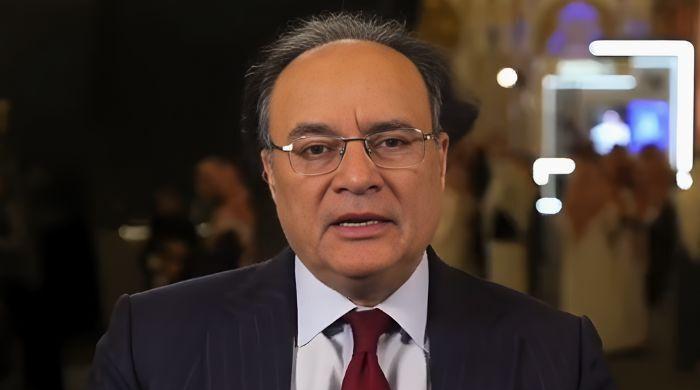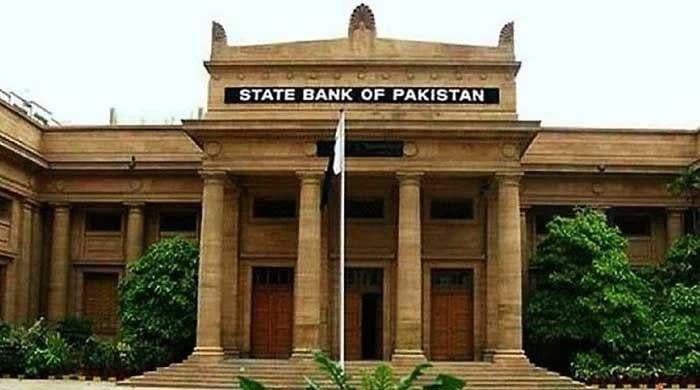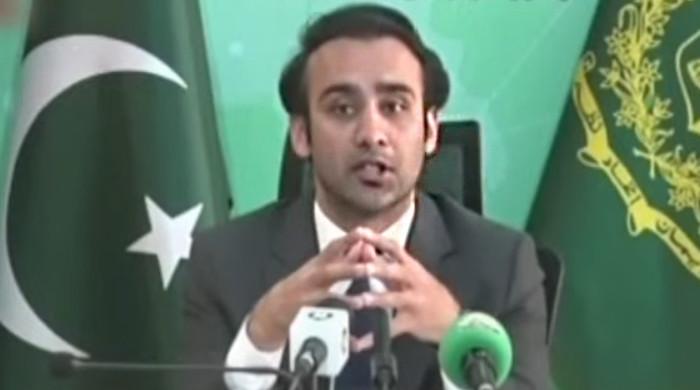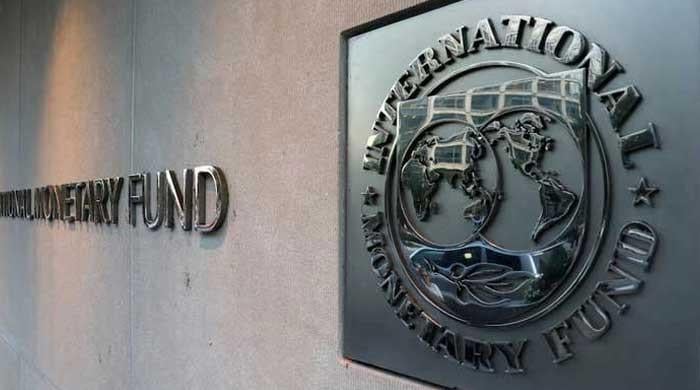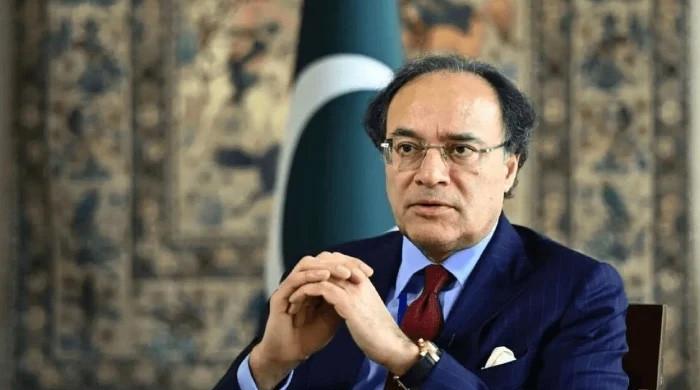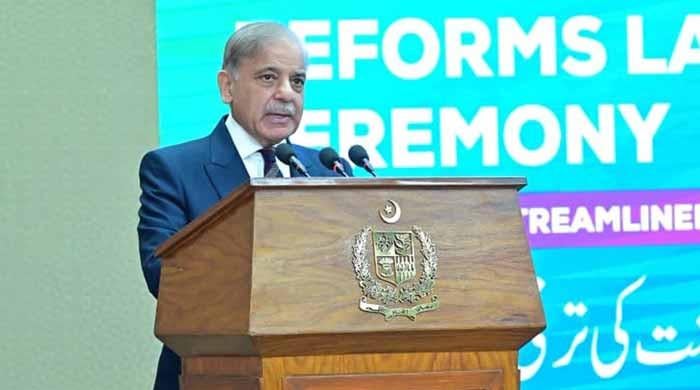Agriculture boosts GDP growth to 2.38%, says FinMin Aurangzeb as other sectors miss targets
"There are no sacred cows, everyone will have to contribute to economy," says Aurangzeb while presenting economic survey
June 11, 2024
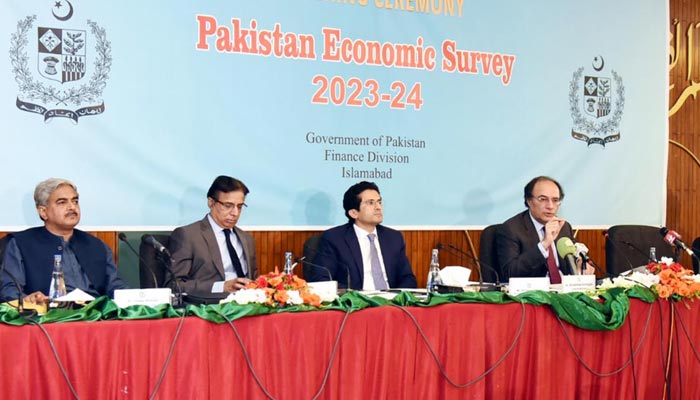
- Pakistan failed to achieve most macroeconomic targets in FY24.
- LSM growth hampered due to interest rate regime: FinMin.
- With IMF deal, he says external financing not a "big challenge".
Finance Minister Muhammad Aurangzeb has said that Pakistan failed to achieve most macroeconomic targets in the FY2023-24 and added that the agriculture sector boosted the GDP growth to 2.38% in the outgoing financial year FY2024.
He said this while presenting the Economic Survey of Pakistan 2023-24, a pre-budget document containing the details of macroeconomic indicators during the outgoing fiscal year, in Islamabad on Tuesday.
The finance czar said growth in the large-scale manufacturing (LSM) was hampered due to the impacts of the interest rate regime and energy equation.
“The agriculture was the ‘saviour’ backed by the bumper crops. Agriculture is going to remain a huge lever of growth as we go forward," Aurangzeb said.
The finance minister said the agriculture sector witnessed the highest growth of 6.25% in 19 years, driven by 16.82% growth in key crops like wheat, rice, and cotton.
Aurangzeb said the agriculture sector is the major pillar of the country's economy and added that everything related to the agriculture and the IT sector has nothing to do with the IMF.
"Half of the agricultural sector is dairy production and livestock," the finance czar said adding that the government will move forward on the principles of ensuring implementation of the policies.
He told the presser that nations run on taxes, not charity as Pakistan recorded a gross domestic product (GDP) growth of 2.38%.
"There are no sacred cows, everyone will have to contribute to this economy. Because schools, hospitals, and universities can run through philanthropy, but not countries, they run on taxes," he told journalists.
For the incoming year, he said the government would manage the policies in the same pattern that it did in the outgoing year, as there would be rollovers and borrowing from commercial banks.
"[...] we are entering the year, on the external financial side, on a much stronger note than we were at the beginning of the last year. Repayments will not be a major issue in the next year," he said.
The finance minister noted that he had held meetings with foreign commercial banks recently as he noted that Pakistan's talks with the International Monetary Fund (IMF) were going well.
"Once the Fund programme is in place, I don't see external financing as a big challenge," the finance minister said as Pakistan's import covers remains above two months, a comfortable position compared to the previous year.
Key takeaways
- Real GDP posts a growth of 2.38% in FY24.
- GDP, valued at current market prices, reaches Rs106,045 billion ($375 billion), with a 26.4% increase from the previous year's Rs83,875 billion ($338 billion)
- Per capita income rises to $1,680, from $1,551 in previous year
- Investment-to-GDP ratio remains at 13.14%, decrease from 14.13% in FY23
- Agriculture sector has shown a growth of 6.25%
- Industrial, services sectors show resilience with each posting growth of 1.21%
"Pakistan rupee depreciated by 29% and the foreign exchange reserves went down to two weeks of import cover in fiscal year 2022-23 that is where we started off," said the finance minister at the start of his press conference.
'Lender of last resort'
The finance minister said the country started off its journey to under take reforms under the leadership of Prime Minister Shehbaz.
"I was in the private sector before joining the finance minister but at that time I was clear that Pakistan had to go to IMF because we did not have any option and that's why its called lender of the last resort," he added.
"If, God forbid, we had not been in the IMF programme, we would not have been discussing the targets here and would have been in a very difficult situation."
The larger-scale manufacturing growth was hampered due to the impacts of the interest rate regime and energy equation, the minister said adding that agriculture was the "saviour" backed by the bumper crops.
"Agriculture is going to remain a huge lever of growth as we go forward," Aurangzeb said.
"On the fiscal side, as far as revenue is concerned, 30% growth was witnessed in the revenue collection which is almost "unprecedented" from the base where we started," the finance minister said appreciating the provinces for delivering on their primary surpluses.
The provinces should be given due credit for fulfilling their commitment," he said.
"[...] unless the provinces had delivered, we would not have been able to deliver what we committed to with the IMF under the 9-month SBA."
The finance czar said during the three months of the current fiscal year, the current account remained surplus and added that the value of the rupee remained stable this year.
'Power theft losses estimated at Rs500bn'
He said the caretaker government took measures to stop smuggling via Afghan transit trade and stop speculation of currency rates by the exchange companies.
"We are trying to prevent currency speculation from happening again in the country, the finance minister said referring to the reports that local currency will fall to 350 against the US dollar.
On the recent cut in the key policy rate, Aurangzeb said interest rate was reduced due to a reduction in inflation.
Emphasising the need for increasing the tax to GDP ratio, the finance minister reiterated that no public corporation is strategic.
He said the losses occurred due to power theft in the country have been estimated at Rs500 billion and added that power distribution companies cannot work in the public sector.
"We intend to continue the policies implemented in 2023-24," the finance minister said adding debt repayments would also continue steadily, while managing debt repayments was not a major issue.
He informed the reporters that commercial loans would be taken this year. "I am going to the United States to talk to rating agencies. Furthermore, Panda bonds may be issued this year, whereas external debt repayments will also continue with support from the IMF programme."
FM Aurangzeb went on to say that "imported inflation has a significant impact on our country". "We will have loans rolled over in the next fiscal year as well."
He said the government was going to digitalise the tax collection system to end human intervention.
'Investment-to-GDP ratio at lowest in 50 years'
Responding to a question about the capacity payments to the independent power producers, the finance minister said such payments had to be obliged under the sovereign commitments.
The minister shed light on the unsustainable nature of the current financial burden, mentioning a whopping Rs1 trillion in losses incurred by the state-owned enterprises (SOEs). On the Pakistan Steel Mills (PSM), he said the fate of the steel giant had been sealed as it would not be revived. "People are still employed there, and gas is being used, but the PSM will only be sold for scrap," Aurangzeb said.
Aurangzeb also admitted that the investment-to-GDP ratio was at its lowest in 50 years. Despite these challenges, he assured that key projects under the Public Sector Development Programme (PSDP) would receive funding. "We can no longer include less critical projects as our hands are tied," he noted.
The minister reaffirmed the role of the National Economic Council (NEC) as a strategic forum, crucial for steering the nation's economic policies amid tight fiscal constraints.
Growth
In the document, the ministry mentioned that the real, fiscal, and external sectors, as well as financial markets, have demonstrated resilience and steady improvement.
In the fiscal year 2024, Pakistan's GDP increased by 2.38%. Valued at current market prices, it reached Rs106,045 billion ($375 billion), with a 26.4% increase from the previous year's Rs83,875 billion ($338 billion).
The per capita income rose to $1,680, from $1,551 in the previous year, driven by improved economic activity and a stable exchange rate. The investment-to-GDP ratio for FY2024 remained at 13.14%, a decrease from 14.13% in FY2023, attributed to a global slowdown, political instability in the country along with restrictive macroeconomic policies.
Agriculture
The agriculture sector has shown a growth of 6.25% in 2023-24 compared to 2.27% last year, driven by healthy growth in important crops. Specifically, there was a significant growth of 16.82% in the production of major crops. Wheat production has witnessed a record growth of 11.6%, reaching 31.4 million tonnes compared to 28.2 million tonnes last year.
Cotton production, which was severely damaged by floods and rains last year, recorded 10.2 million bales compared to 4.9 million bales last year, growing by 108.2%.
Rice production also saw a significant increase, reaching 9.9 million tonnes compared to 7.3 million tonnes last year, representing a growth of 34.8%.
During July-March FY2024, agricultural lending by financial institutions totalled Rs1,635.2 billion, achieving 72.7% of the overall annual target and marking a 33.8% increase from Rs1,221.9 billion disbursed during the same period last year.
The outstanding portfolio of agricultural loans increased by Rs105.8 billion, reaching Rs818.7 billion at the end of March 2024, compared to Rs712.9 billion at the end of March 2023, reflecting a 14.8% growth.
The number of outstanding borrowers reached 2.70 million by the end of March 2024.
Industrial sector
After experiencing a downturn in FY 2023, the document mentioned, the industrial sector has rebounded, recording a growth of 1.21% in FY 2024.
The sector's performance heavily relies on manufacturing, which constitutes 65.3% of the industry.
The mining and quarrying sector, which makes up 9.1% of the industry, observed a growth of 4.85%, contrasting with its decline in the previous year.
A rise in crude oil, coal, marble, limestone, and laterite production during FY24 fueled this increase.
Furthermore, the GFCF of the private sector in mining and quarrying achieved significant growth of 10.5% in FY24 over the positive growth in FY23, indicating support for overall positive growth in this sector.
Sector-wise growth:
- Textile -8.27%
- Food 1.69%
- Beverages -3.43%
- Tobacco -33.59%
- Wearing Apparel 5.41%
- Nonmetallic mineral products -3.89%
- Wood 12.09%
- Coke and Petroleum — 4.85%
- Pharmaceuticals — 23.19%
Inflation
The document mentioned that the CPI inflation for the period July-April FY24 was recorded at 26.0% as against 28.2% during the same period last year.
The other inflationary indicators like the Sensitive Price Indicator (SPI) recorded at 30.2% as against 31.7% last year.
The Wholesale Price Index (WPI) recorded at 22.4% in July-April FY2024 compared to 34.1% in the same period last year.
The coordinated policy response in Pakistan has significantly reduced inflation to 17.3% in April 2024 from its peak of 38% in May 2023.
Similarly, food inflation (Urban) declined from 48.1% in May 2023 to 11.3% in April 2024. It is expected that inflation will continue to decrease in the upcoming months.
The decline in inflation is broad-based, reflecting fiscal consolidation, smooth supplies of food items, favourable global commodity prices, and the base effect.
Fiscal deficit
The fiscal deficit during July-March FY24 was recorded at 3.7% of GDP, the same as last year.
Meanwhile, the primary balance posted a surplus of Rs1615.4 billion (1.5% of GDP) during July-March FY2024, compared to the surplus of Rs503.8 billion (0.6% of GDP) last year.
The current account showed improvement, with the current account deficit decreasing from $3.9 billion last year to $0.2 billion in July-April FY24.
This improvement was due to a 10.6% increase in exports and a 5.3% drop in imports of goods.
Revenue
Total revenues grew by 41% in July-March FY24, compared to the growth of 18.1% observed last year, the document mentioned.
The substantial increase in revenues has been primarily attributed to a sharp rise in non-tax revenues, which grew by 90.7%, driven by higher receipts from SBP profit, petroleum levy, markup (PSEs and others), and royalties on oil/gas, etc.
Total tax collection (federal and provincial) grew by 29.3% during July-March FY24, compared to the growth of 16.5% last year.




